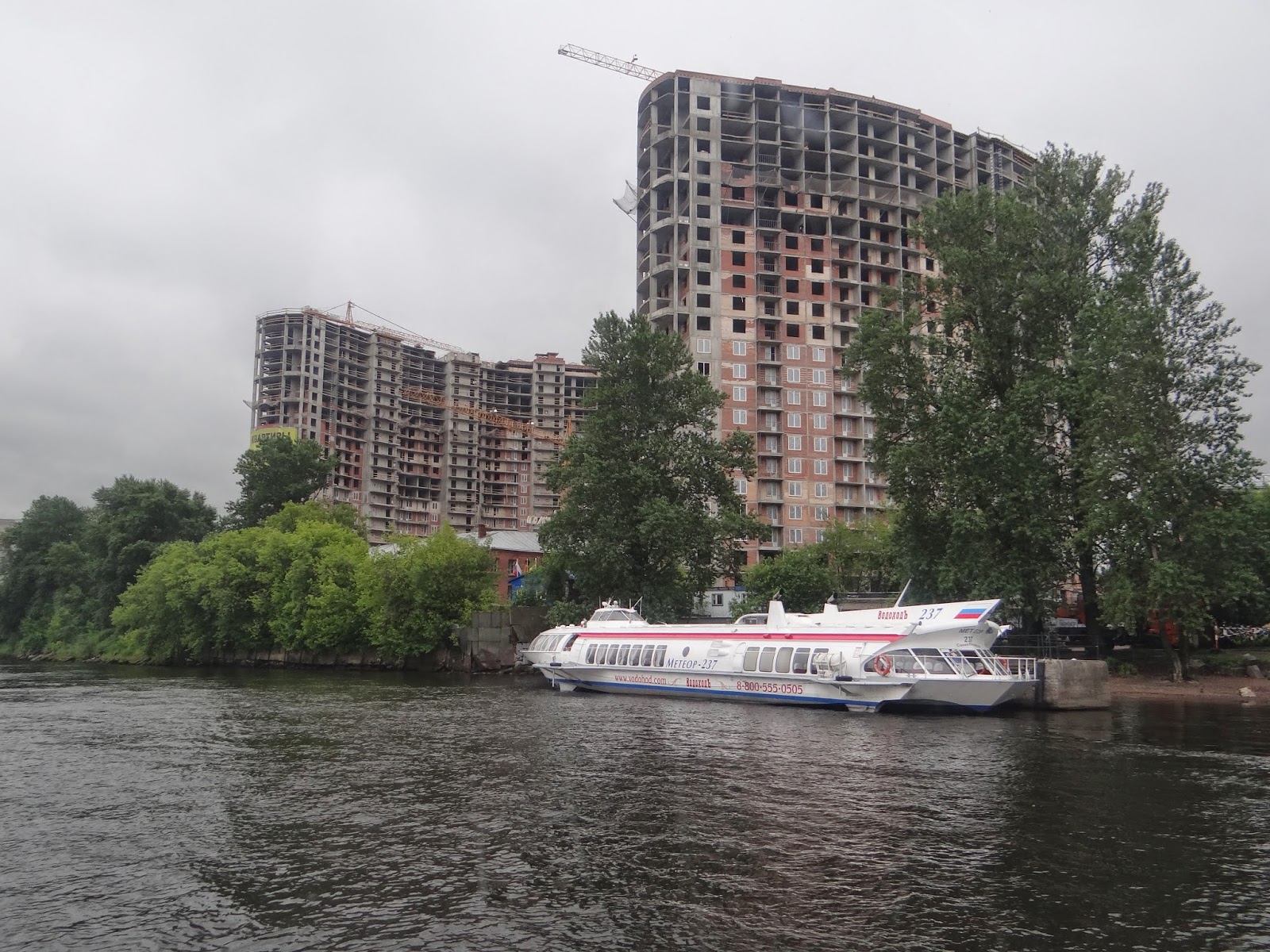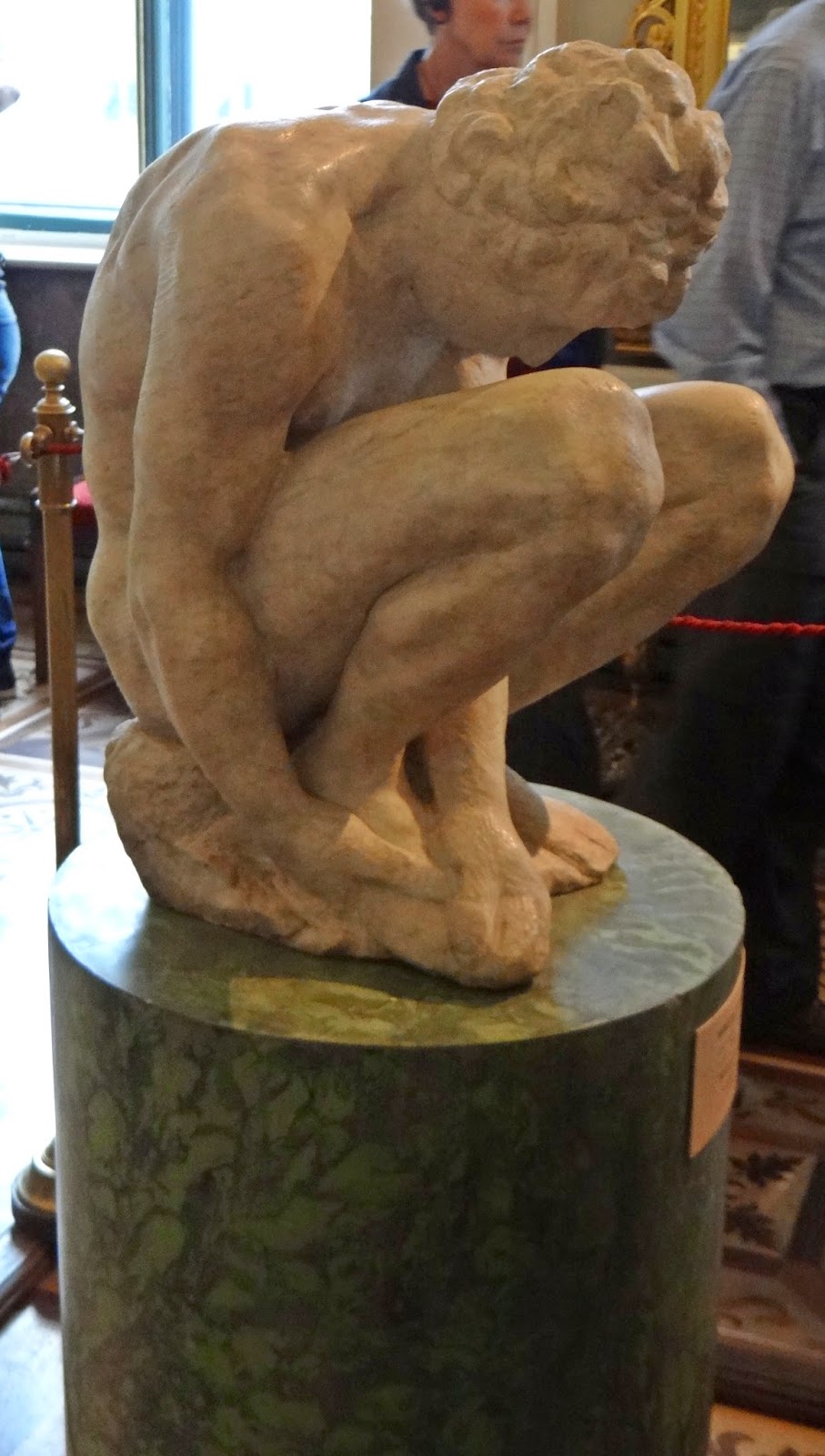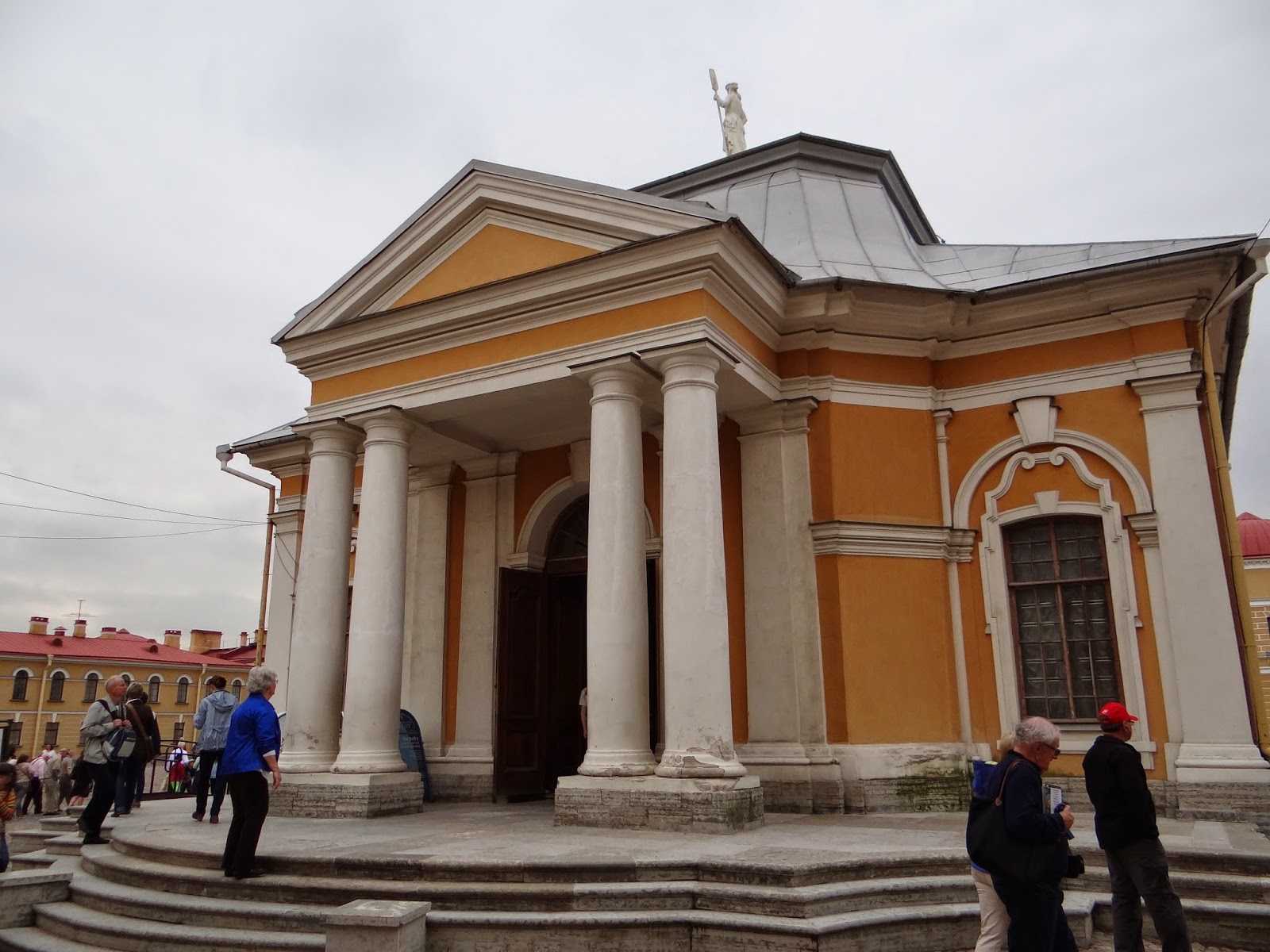Like Venice, St. Petersburg is a city of islands, rivers and canals, and hundreds of bridges. It was founded by Peter the Great in 1703. It is Russia's second largest city with a population of 5 million people.
We would be in St. Petersburg on the ship for three days before the cruise ended. These are the hydrofoils that are used to get around the city, which are much faster than going by car with all the traffic. Today we would be taking one to see the Hermitage and the Winter Palace.
Some of the modern buildings along the water. The larger one is called the Tea Kettle.
These apartment buildings are fairly new...
This is the Peter and Paul Fortress, which I seemed to take a picture of every time I saw it, like I hadn't seen it before. Peter the Great moved the capital from Moscow to St. Petersburg and wanted a stronghold to control the river. He chose Zayachy (Hare) Island on the Neva River as the site of his fortress, a short distance from the Gulf of Finland. We would be visiting it later in the afternoon.
The Admiralty...
This picture shows the palace from which tsars ruled for 150 years. The Hermitage consists of five linked buildings: the Winter Palace, little Hermitage, the old and new Hermitage, and the Hermitage Theatre.
Behind is the Alexander Column and the State Headquarters. When I saw it several days later, I was sure I had never seen it before, when in fact I’d already taken a pic of it. Too many places!
Here we are at the Winter Palace, which includes the Hermitage. It would be impossible to get a picture that shows how huge it is. We were there early and there was already a line-up. The Winter Palace was started by Elizabeth, and then Catherine the Great expanded it. It used to be about 50 m in length and she made it into a 250 m long collection of buildings.
The Jordan Staircase in the Winter Palace...much of the palace is not how it appeared originally due to a disastrous fire in 1837. However, the staircase still looks as it did in the 18th century.
This bronze vase with a malachite veneer was saved during the fire of 1837.
It was too overwhelming to take in during our short visit...
Everything is gilded (gold over wood)...
One of the many (many!) portraits we would see of Catherine the Great. She ruled from 1762-1796.
An amazing mosaic floor created for Catherine the Great...look at the tiny pieces and intricate designs.
The hanging gardens of the Winter Palace...
We began a whirlwind tour of the Hermitage. Our guide for the next couple of days, while very knowledgeable, lacked any enthusiasm. I think she had done just a few too many tours. So she would talk about a painting and move on, while we were still trying to digest what she said.
We began with a group of paintings by Rembrandt. The Hermitage has 35 Rembrandts, the greatest collection in the world.
This is the Portrait of Baertje Martens (ca. 1640). Paintings of her and her husband were commissioned for the family and were preserved by two generations of descendants. By the mid-eighteenth century, through several auction sales, the works ended up in different collections. The portrait of Baertje Martens has been in the Hermitage Gallery since 1767. The painting of her husband has been in the collection of the Metropolitan Museum in New York since the 1930s.
The Holy Family with Angels (1645) by Rembrandt...
Rembrandt's Descent from the Cross was painted in 1634. It remained in the Netherlands until it was confiscated by the French in 1806, and then bought by Alexander I of Russia after the fall of Napoleon. It has been in the Hermitage since then.
Saskia as Flora was painted by Rembrandt in 1634. He painted this goddess of spring and flowers three separate times: this one in the Hermitage; another in 1635, which is in the National Gallery in London; and another in 1641, which is in Germany.
This painting is Danae, created by Rembrandt in 1636. It was acquired by Catherine the Great in 1772 for the Hermitage and was considered one of its masterpieces. On June 15, 1985, a man slashed the canvas twice with a knife and threw acid over it. Later, the man was judged to be insane.
Immediately the complex process of restoration began. The damaged canvas was taken out of its frame and carried to a restoration studio. The surface of the canvas was doused with water to neutralize the acid. By evening, when the power of the acid had been contained and the physical condition of the surface had been stabilized, it was discovered that over 70 percent of the paint surface remained undamaged. It took over two years to restore it. Although Natalia, our guide, told us traces of the damage still remain, it was difficult to see.
One of the many statues...
The Nativity by Giovanni della Robbia (1469-1529), an Italian ceramic artist.
And a work by his father, Andrea della Robbia (1435-1525).
Many art students must copy the masters as part of their program...
The amazing ceilings with chandeliers...art everywhere, but no time to look at it.
Another student painting...
Tapestries were an important part of western European interiors from the medieval period, and the Hermitage's collection is the largest in Russia.
Madonna with Child by Leonardo da Vinci (1452-1519). It was most likely painted in Milan and came to the Hermitage in 1865. A preparatory drawing for the Madonna's head is in the Louvre in Paris.
Our tour guide, Natalia...behind her are the doors of the Leonardo room decorated in the Boulle technique (inlay with tortoise-shell and copper).
The Danae series comprises at least five oil-on-canvas paintings by the Venetian master, Titian (1490-1576), completed between 1553 and 1556.
Also by Titian, St. Mary Magdalene, painted in the 1550s...
Saint Sebastian, also by Titian, painted around 1570...
Portrait of a Man by Domenico Robusti (1562-1637)...look at the crispness of his collar.
The Raphael Loggias in the Hermitage is a copy of the famous Gallery created in the 16th century in the Vatican Palace. Its walls and vaults were painted by Raphael's pupils after his sketches and under his supervision.
One of the sections of the hall. Raphael's (1483-1520) frescoes took 15 years to copy.
The darker section shows the walls before restoration work.
The Small Italian Skylight Room in the New Hermitage is one of three enormous interiors lit from above.
Another art student...
Lute Player by Caravaggio (1571-1610)...painted in 1596, it exists in three different versions.
Another Madonna and Child, this one by Raphael, was painted in 1502-1503...
Madonna with Beardless St. Joseph by Raphael painted in 1506 is the only portrait of Joseph without a beard.
A Dead Boy on a Dolphin in marble by Lorenzo Lorenzetti (1490-1541), a disciple of Raphael.
Next stop, the Michelangelo exhibit...
The Crouching Boy by Michelangelo (1475-1564) is his only work in the Hermitage. I believe the story we were told is that he was given a block of marble this size and challenged to make a full-sized figure out of it. Or it could have deeper meaning that some scholars see like an allegory for the unborn soul, while others see the figure as a wounded soldier or a spirit of mourning. I like the simple story better.
Mary Magdalene Taken Up to Heaven by Domenico Zampieri (1581-1641)...
Death of Adonis (1709) in marble by Mazzuola (1641-1725)...
Portrait of the Actress Antonia Zarate (1810-1811) by Franciso de Goya (1746-1828). This painting came from the collection of Armand Hammer in 1972.
Boy with a Dog by Bartolome Esteban Murillo (1617-1682). This was a Hey! moment as I had watched the movie American Hustle on the plane where they talked about this painting.
Kiss of Cupid and Pysche by Antonio Canova (1757-1822). The god Cupid is awakening the lifeless Psyche with a kiss...
Another of the great halls...
Self-portrait Anthony Van Dyck (1599-1641)...many short lives...
Bacchus, the god of wine and merriment, by Peter Paul Rubens (1577-1640). This was not a commissioned work, and the artist kept it in his studio until the end of his life.
The throne of Tsar Nicholas II, upholstered in shimmering new red velvet, was restored to its original home in the Winter Palace in 2000, more than 80 years after it was trashed by Communists.
St. George Hall in the Winter Palace (the throne is at the other end). The motifs on the floor were replicated in the ceiling.
Alexander I of Russia in the Military Gallery...
In this room, you could also see how dim and dark the ceiling was before restoration.
This painting depicts the Russians scoring a decisive victory over Napoleon.
And this shaky picture is what the crowds now looked like. It was insane, unpleasant, and definitely time to leave. My head was totally on overload...
We went for lunch at Academy, a very nice restaurant. However, it was quite busy and loud and my memory of that lunch is just wanting it to be over. This is the former stock exchange building near the restaurant.
Beautiful architecture of the buildings...
Near the former stock exchange building is a pair of Rostral Columns. They are constructed of brick coated with a deep terra cotta red stucco and decorated with bronze anchors and four pairs of bronze ship prows. They were originally intended to serve as beacons and continue to be lit on some ceremonial occasions.
After so much information, it was nice to sit in the sun and watch two little boys playing.
We were now on our way to the Peter and Paul Fortress. There appeared to be boat races on the Neva River.
The Peter and Paul Cathedral is one of the city's landmarks. Its spire is covered with gold and is 402 ft tall. No wonder I kept seeing it every day! The cathedral was built between 1712 and 1733.
All of the tsars have been buried in this church, with the exception of Peter II who is buried at the Kremlin.
Amazing ceilings...
The pulpit...
The front of church...could there be any more gold?
And continuing upwards to the ceiling...
All of the tombs are made of white marble, except for those of Alexander II and his wife.
Only July 17, 1998, eighty years after their execution, the remains of Tsar Nicholas II, his family, their doctor and close servants were retrieved from a mineshaft and authenticated with DNA tests. They were brought here to rest with their ancestors.
The Grand Ducal Mausoleum was constructed in order to remove the remains of some of the non-reigning Romanovs from the cathedral; there was scarcely any room for new burials. It is connected to the cathedral by a corridor.
One of the oldest industrial enterprises in St. Petersburg, the main building of the Mint was constructed from 1800-1805 to replace coining workshops, which had been producing money and medals since 1724. The Mint continues to produce coins, state awards, and other official medals.
This was the original boathouse, built to house Peter the Great's dinghy, a small sailboat that had been used by the young tsar to learn naval principles on the lakes in the Moscow area. It is now used as a ticket office for the exhibitions and museums in the fortress.
Walls of the fortress...the fortress never had a direct military purpose, since no enemy ever made it as far as its walls. It was used as a political prison and torture chamber. Peter the Great's son, Alexei, was brought here, tortured and executed.
The back of the Mikhailovsky Castle, which served as the imperial residence for only 40 days.
As in Moscow, we saw tons and tons of limos. Every time you turned around, it seemed like you saw a wedding.
Gostiny Dvor is a Russian historic term for an indoor market and this was one of the first shopping centres in the world. Construction began in 1757.
Our next stop (I was no longer absorbing much information) was the monument to Nicholas I in front of St. Isaac’s cathedral. Unveiled on July, 1859, the 6 m statue was a technical wonder of its time. It was the first equestrian statue in Europe with only two support points (the rear hooves of the horse).
Next stop, the Smolny Monastery...it’s also a very popular place to take wedding photos. By the time I got out of the bus, Yvonne was on the run determined to get a photo of the wedding couple. Go, Yvonne!
Elizabeth, who ruled from 1741-1762, decided she was going to hand over the reigns of the government to her nephew, Peter, and end her days peacefully in a convent. Not seeing anything suitable, she had this built as a religious retreat for women.
Beautiful windows...
The completed bell tower would have made it the tallest building in St. Petersburg, but Elizabeth died before its completion. The building was closed by the Soviets in 1923 and was allowed to decay until 1982 when it became a concert hall.
Definitely the most unique limo we saw...it looked like Cinderella’s carriage.
What a day with beautiful sights, even if we didn't have time to absorb all of them. Tomorrow we are off to visit Catherine's Palace...





















































































1 comment:
Beautiful.
I am vising petersburg next week.
Thanks,
Jai
Post a Comment